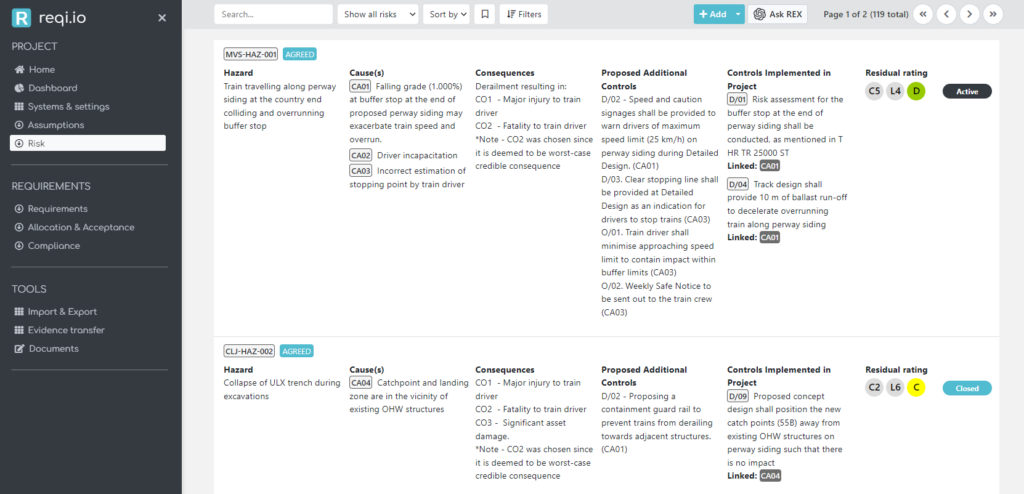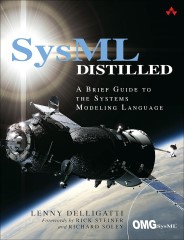So, what is a hazard log? A hazard log is a structured document used in safety management across industries to systematically identify, assess, and manage potential hazards and associated risks. It serves as a central repository of information, cataloging identified hazards, their potential consequences, risk assessments, mitigation measures, and status updates. This proactive tool ensures compliance with safety standards, fosters a culture of safety, and enables informed decision-making by providing a clear, organized record of safety-related data, ultimately reducing the likelihood of accidents and incidents in projects, systems, or operations.
Table of Contents
- Alternative Names for a Hazard Log
- Key Components and Functions of a Hazard Log
- Hazards and Safety Risk in Systems Engineering
- Legal and Regulatory Compliance
- Training and Implementation Best Practices
- Integration with Other Safety Management Systems
- Frequently Asked Questions
- What is a Hazard Log?
- How can I create a Hazard Log?
- What is the purpose of a Hazard Tracking Log?
- Are there any alternative names for a Hazard Log?
- What information should be included in a Hazard Log?
- What is the difference between a hazard and a risk?
- Why is a Hazard Log important in safety management?
- Where can I find a Hazard Log template or example?
- How often should a Hazard Log be reviewed and updated?
- What is the role of a Hazard Log in risk communication?
- Can a Hazard Log be used in industries beyond safety-critical sectors?
Alternative Names for a Hazard Log
This list provides alternative names for a Hazard Log, each with a brief description, and these various terms are used in different contexts and industries:
- Safety Hazard Log: Emphasizes safety-related hazards.
- Risk Register: Records and manages risks, including hazards.
- Risk Log: Tracks and monitors risks and safety concerns.
- Safety Risk Register: Focuses on safety risk management.
- Hazard and Risk Log: Emphasizes both hazards and risks.
- Safety Compliance Log: Ensures safety compliance.
- Incident and Hazard Log: Includes both incidents and hazards.
- Incident Register: Primarily focuses on incidents but may track hazards.
- Safety Assurance Log: Emphasizes safety assurance.
- Risk and Safety Record: Records hazards and risk management efforts.
- Safety Risk Tracker: Focuses on tracking safety risks.
Key Components and Functions of a Hazard Log
Hazard Identification
At the core of a Hazard Log is the systematic identification of potential hazards. This process involves a comprehensive examination of a project, system, or operation to identify any unsafe conditions, events, or circumstances that could pose a threat to safety.
Effective hazard identification is crucial for anticipating and preventing accidents or incidents before they occur. In safety-critical industries, a variety of techniques are employed, such as:
- Fault Tree Analysis (FTA): FTA is a deductive approach that starts with a specific undesired event and works backward to identify its potential causes or contributing factors.
- Hazard and Operability Study (HAZOP): HAZOP involves systematic examination of a system to identify deviations from design intent that could lead to hazards.
- FMEA/FMECA (Failure Modes and Effects Analysis/Failure Modes, Effects, and Criticality Analysis): These methodologies assess the potential failure modes and their effects on system functionality and safety.
- Checklists and Expert Input: Utilizing checklists and drawing upon the expertise of subject matter experts (SMEs) are essential for identifying both common and domain-specific hazards.
Risk Assessment
Once hazards are identified, they need to be assessed to understand their significance and prioritize mitigation efforts. Risk assessment involves evaluating the severity, likelihood, and consequences of potential incidents resulting from each hazard.
The following factors are typically considered during risk assessment:
- Severity: The extent of harm or damage that could result from a hazard, often categorized into levels such as minor, moderate, major, or catastrophic.
- Likelihood: The probability or frequency with which a hazard might lead to an incident, often classified as low, moderate, high, or rare.
- Consequences: The outcomes and impacts of an incident, including harm to people, damage to property, financial loss, and environmental effects.
Risk matrices, heat maps, or numerical scoring systems may be employed to assign risk levels to each hazard, helping prioritize actions based on the assessed risk.
Risk Mitigation
After assessing risks, the Hazard Log records the measures and controls put in place to mitigate or eliminate identified hazards. Risk mitigation strategies are designed to reduce the likelihood and severity of potential incidents, making the project, system, or operation safer.
Common risk mitigation measures include:
- Engineering Controls: Modifications to the design, configuration, or layout of a system to eliminate or reduce hazards, such as adding safety interlocks or redundancy.
- Procedural Controls: Implementation of specific procedures, protocols, or operating instructions to minimize risk, including emergency response plans and safety guidelines.
- Protective Equipment: Providing personal protective equipment (PPE) to individuals working in hazardous environments, such as safety helmets, gloves, or respirators.
- Training and Education: Ensuring that personnel are adequately trained and educated about potential hazards and safe operating practices.
The Hazard Log keeps track of the status of these actions, monitors their effectiveness, and records any adjustments or improvements made over time.
Monitoring and Reporting
A robust Hazard Log supports ongoing monitoring of hazards and risks throughout the project, system, or operation lifecycle. It provides mechanisms for reporting new hazards, assessing changes in risk levels, and capturing lessons learned from incidents or near-misses.
Continuous monitoring allows organizations to:
- Stay Proactive: By identifying emerging hazards or changes in risk conditions, organizations can take timely preventive actions.
- Comply with Regulations: Many safety-critical industries are subject to regulatory requirements that mandate the monitoring and reporting of hazards and incidents.
- Improve Safety Culture: Encouraging a culture of safety where all team members are vigilant about identifying and reporting hazards fosters a safer work environment.
Compliance and Documentation
In safety-critical industries, compliance with safety standards and regulatory requirements is paramount. The Hazard Log serves as a central repository for documenting and demonstrating compliance-related information.
Key functions related to compliance and documentation include:
- Regulatory Alignment: Ensuring that safety procedures and risk management practices align with industry-specific regulations and standards.
- Audit Trail: Maintaining a comprehensive record of all safety-related activities, decisions, and actions taken throughout the project’s lifecycle.
- Reporting to Authorities: Providing necessary documentation to regulatory authorities as part of safety assessments and audits.
This documentation not only helps organizations meet legal requirements but also serves as a valuable resource for internal audits and continuous improvement initiatives.
Communication
Effective communication of hazard information is crucial for ensuring that all relevant stakeholders are aware of potential risks and mitigation efforts. The Hazard Log facilitates this communication by:
- Sharing Information: Making hazard and risk information available to project managers, safety engineers, team members, and external stakeholders.
- Transparency: Promoting transparency about the safety status of the project or operation, enabling informed decision-making.
- Alerts and Notifications: Notifying responsible parties of changes in risk levels, status updates on mitigation measures, and safety-related incidents or concerns.
Clear and effective communication helps prevent misunderstandings and ensures that safety remains a top priority throughout the project’s lifecycle.
Continuous Improvement
A proactive approach to safety involves learning from past incidents, near-misses, and hazard assessments to continuously improve safety practices and procedures. The Hazard Log plays a key role in supporting this continuous improvement by:
- Lessons Learned: Documenting insights gained from safety-related incidents or changes in risk conditions.
- Root Cause Analysis: Investigating the underlying causes of incidents to prevent their recurrence.
- Updating Risk Assessments: Reassessing risks as new information becomes available and making necessary adjustments to risk mitigation strategies.
By fostering a culture of continuous improvement, organizations can enhance safety, reduce the likelihood of incidents, and adapt to evolving risk factors.
Hazards and Safety Risk in Systems Engineering
In systems engineering, the identification and management of hazards and safety risks are integral components of the design, development, and operation of complex systems. Systems engineering involves a holistic approach to designing and integrating components, subsystems, and processes to achieve desired functionality while considering safety, reliability, and performance.
Below is a table outlining the linkage between hazards, safety risk, and systems engineering:
| Aspect | Description |
|---|---|
| Identification of Hazards | Systems engineers employ techniques such as functional hazard analysis (FHA) and system hazard analysis (SHA) to identify potential hazards and failure modes within a system. |
| Risk Assessment and Mitigation | Engineers assess safety risks by analyzing the severity, likelihood, and consequences of potential incidents. Techniques such as failure mode effects analysis (FMEA) guide the implementation of risk mitigation measures. |
| Integration of Safety Requirements | Systems engineering frameworks incorporate safety considerations throughout the system development lifecycle. Safety requirements are defined, allocated, and traced to system components to ensure compliance. |
| Iterative Improvement | Systems engineering emphasizes iterative development and continuous improvement, allowing for the refinement of safety-critical systems over time based on lessons learned from previous projects and operational experience. |
Legal and Regulatory Compliance
Ensuring compliance with safety standards and regulatory requirements is paramount in safety management across industries. Hazard Logs play a crucial role in helping organizations meet these obligations by providing a structured framework for documenting and managing safety-related information in accordance with legal and regulatory mandates.
Industry-Specific Regulations
Different industries are subject to specific regulations and standards governing safety management practices. For instance, sectors such as aviation, healthcare, construction, and manufacturing have industry-specific regulatory bodies and guidelines that prescribe safety protocols and requirements. Hazard Logs must align with these regulations to ensure that organizations operate within legal boundaries and uphold industry standards.
Occupational Health and Safety Legislation
Many countries have legislation in place to protect workers’ health and safety in the workplace. These laws typically mandate the identification, assessment, and mitigation of workplace hazards to prevent accidents and injuries. Hazard Logs serve as a documentation tool to demonstrate compliance with occupational health and safety regulations, providing a record of hazard identification, risk assessments, and mitigation measures.
Environmental Regulations
In addition to worker safety, environmental protection is a critical aspect of safety management, particularly in industries with potential environmental impacts, such as oil and gas, chemical manufacturing, and transportation. Hazard Logs may include provisions for documenting environmental hazards and risks, as well as measures to mitigate adverse environmental effects, ensuring compliance with environmental regulations and sustainability goals.
Reporting Requirements
Regulatory authorities often require organizations to report safety-related incidents, hazards, and near-misses as part of safety monitoring and compliance efforts. Hazard Logs facilitate compliance with reporting requirements by providing a centralized repository of incident data, including details of the event, its causes, and corrective actions taken. Timely and accurate reporting helps regulatory agencies assess safety performance, identify trends, and enforce compliance with regulations.
Audit and Inspection Preparation
Hazard Logs serve as valuable documentation during regulatory audits and inspections, providing evidence of proactive hazard management practices and compliance with regulatory requirements. Organizations can use Hazard Logs to demonstrate due diligence in identifying and mitigating safety risks, thereby mitigating potential penalties or sanctions resulting from non-compliance.
Continuous Updates and Revisions
Regulatory requirements may evolve over time due to changes in industry standards, technological advancements, or emerging safety concerns. Organizations must regularly review and update their Hazard Logs to ensure alignment with current regulations and best practices. Continuous monitoring and adaptation of safety management processes are essential to maintaining compliance and enhancing safety performance.

By addressing legal and regulatory compliance considerations in safety management, Hazard Logs help organizations fulfill their obligations to protect workers, the environment, and the public while promoting a culture of safety and accountability.
Training and Implementation Best Practices
Effective implementation of Hazard Logs requires thorough training and adherence to best practices. Providing comprehensive training programs and following established implementation guidelines are essential for maximizing the effectiveness of Hazard Logs in safety management.
Below is a table outlining key training and implementation best practices:
| Best Practice | Description |
|---|---|
| Customized Training Programs | Develop tailored training programs that address the specific needs and roles of individuals involved in hazard identification, risk assessment, and mitigation activities. Training should cover the purpose of Hazard Logs, how to use them effectively, and reporting procedures. |
| Hands-on Exercises | Provide hands-on exercises and simulations to reinforce learning and practical application of Hazard Logs. Encourage participants to practice hazard identification, risk assessment, and mitigation techniques in a controlled environment. |
| Continuous Education | Offer ongoing education and refresher courses to ensure that personnel remain updated on safety management practices, regulatory requirements, and changes to Hazard Log procedures. Continuous education helps reinforce a culture of safety and accountability. |
| Leadership Support | Secure commitment and support from organizational leaders to prioritize safety initiatives, allocate resources for Hazard Log implementation, and foster a culture of safety throughout the organization. Leadership involvement is critical for driving change and sustaining safety improvements. |
| Regular Reviews and Feedback | Conduct regular reviews and solicit feedback from users to evaluate the effectiveness of Hazard Logs and identify areas for improvement. Encourage open communication and collaboration to address challenges and implement enhancements that enhance usability and functionality. |
| Stakeholder Engagement | Engage stakeholders from various levels of the organization, including management, frontline workers, safety personnel, and regulatory authorities, to ensure buy-in and commitment to the Hazard Log implementation process. |
Integration with Other Safety Management Systems
In addition to serving as a standalone tool for hazard identification and risk management, Hazard Logs can be seamlessly integrated with other safety management systems and tools to enhance overall safety practices and outcomes. Integration fosters collaboration, streamlines data sharing, and provides a more comprehensive view of safety management practices within an organization.
Incident Reporting Systems
Hazard Logs can complement incident reporting systems by capturing information about hazards identified during incident investigations. Integrating Hazard Logs with incident reporting systems enables organizations to correlate hazard data with incident data, facilitating root cause analysis and identifying systemic safety issues. By consolidating hazard and incident information, organizations can implement targeted corrective actions to prevent recurrence and improve overall safety performance.
Safety Audits and Inspections
Integrating Hazard Logs with safety audit and inspection systems enables organizations to track compliance with safety protocols and regulatory requirements. Hazard Logs can serve as a reference during safety audits, providing evidence of hazard identification efforts, risk assessments, and mitigation measures implemented. By linking Hazard Logs with audit findings, organizations can prioritize corrective actions and demonstrate continuous improvement in safety management practices.
Risk Assessment Methodologies
Hazard Logs can be integrated with risk assessment methodologies, such as Bowtie Analysis or HAZOP studies, to enhance the accuracy and effectiveness of risk management efforts. By incorporating hazard data from Hazard Logs into risk assessments, organizations can better understand the relationship between hazards, their consequences, and the likelihood of occurrence. This integrated approach enables organizations to prioritize resources and implement targeted risk mitigation strategies based on the most critical hazards identified.
Safety Management Software Solutions
Many organizations use specialized safety management software solutions that encompass various safety management processes, including hazard identification, risk assessment, incident management, and compliance tracking. Integrating Hazard Logs with these software solutions centralizes safety data, streamlines workflows, and enhances data visibility and analysis capabilities. By leveraging the interoperability of safety management software, organizations can optimize safety management practices and drive continuous improvement in safety performance.
Collaborative Tools and Communication Platforms
Integrating Hazard Logs with collaborative tools and communication platforms enables real-time sharing of hazard information among stakeholders, fostering collaboration and proactive risk management. By providing access to Hazard Logs through centralized platforms, organizations can ensure that relevant stakeholders have visibility into safety-related information and can contribute to hazard identification, risk assessment, and mitigation efforts effectively.
By integrating Hazard Logs with other safety management systems and tools, organizations can achieve a more holistic approach to safety management, driving continuous improvement in safety performance and fostering a culture of safety throughout the organization.
Recommended Further Reading Amazon BooksFrequently Asked Questions
What is a Hazard Log?
A Hazard Log is a structured document used to systematically identify, assess, and manage potential hazards and risks associated with projects, systems, or operations. It plays a crucial role in safety management across various industries.
How can I create a Hazard Log?
To create a Hazard Log, you can start with a hazard log template or use a hazard log example as a reference. Begin by identifying potential hazards, assessing their risks, and documenting risk mitigation measures.
What is the purpose of a Hazard Tracking Log?
A Hazard Tracking Log is a component of the Hazard Log used to monitor and manage hazards and risks over time. It helps in tracking the status of risk mitigation measures and documenting changes in risk levels.
Are there any alternative names for a Hazard Log?
Yes, a Hazard Log is known by various names, including Risk Register, Safety Hazard Log, Risk Log, Safety Risk Register, Hazard and Risk Log, Safety Compliance Log, Incident and Hazard Log, Incident Register, Safety Assurance Log, Risk and Safety Record, and Safety Risk Tracker.
What information should be included in a Hazard Log?
A Hazard Log should include details about identified hazards, their potential consequences, risk assessments, risk mitigation actions, responsible parties, status updates, and any lessons learned from incidents or near-misses.
What is the difference between a hazard and a risk?
To put it simply, a hazard is any possible source of harm or negative health impact, while risk pertains to how likely it is for someone to be harmed when faced with a hazard. A clear grasp of these concepts is undeniably the key to effective risk management in our industry.
Why is a Hazard Log important in safety management?
A Hazard Log is essential in safety management because it helps organizations proactively identify and mitigate potential safety risks. It ensures compliance with safety standards, supports informed decision-making, and promotes a culture of safety within the organization.
Where can I find a Hazard Log template or example?
Hazard Log templates and examples are available from various sources, including safety management software providers, industry-specific guidelines, and online resources. You can start your search on safety management websites or professional organizations related to your industry.

How often should a Hazard Log be reviewed and updated?
The frequency of Hazard Log reviews and updates can vary depending on the nature of the project or operation. Generally, it’s advisable to review the Hazard Log regularly, especially when there are changes in the project, system, or operating conditions. Continuous monitoring is essential to ensure its relevance and effectiveness.
What is the role of a Hazard Log in risk communication?
A Hazard Log offers crucial information, acting as a comprehensive resource for possible hazards and risks. This tool aids key individuals – management, staff, and regulators – in grasping the safety position of a project or system, promoting open discussion surrounding risk reduction strategies.
Can a Hazard Log be used in industries beyond safety-critical sectors?
Certainly! Whilst Hazard Logs are commonly found in areas like aviation and healthcare, they are far from exclusive to these sectors. In truth, their advantages reach across an impressive array of industries. For example, in fields such as project management, engineering, or quality assurance, Hazard Logs are incredibly beneficial. They serve as an excellent tool, not merely managing risks but also augmenting overall function.













